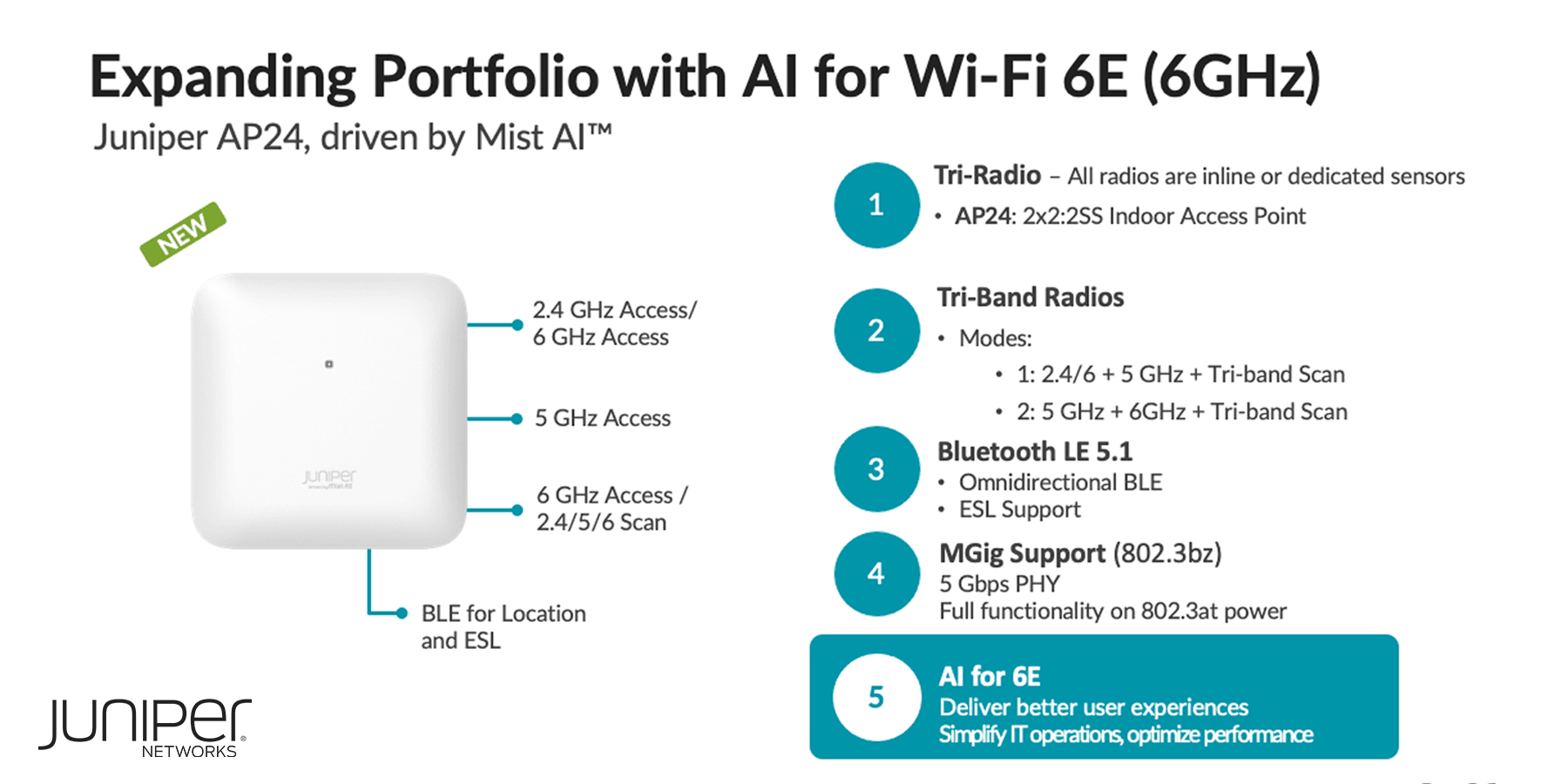Partner POV | Where Goes Apple, Goes the Industry: What Wi-Fi 6E Means for the Future of Wireless
In this article
Article written by Jeff Aaron, VP of Enterprise Marketing, at Juniper Networks.
Unless you were catching up on some much-needed sleep, you know by now that Apple unveiled its new iPhone on September 12, 2023. The iPhone 15 Pro and Pro Max were announced, and as expected, they feature several new bells and whistles, improvements in camera quality, battery life and a lightweight titanium design to encourage users to upgrade their existing devices right away.
There is one new feature that stood out to us at Juniper Networks, however, among the rest of the hype about USB-C connectors and the need for everyone to purchase completely new charging cables once again: the iPhone 15 Pro and iPhone 15 Pro Max now support Wi-Fi 6E for next-level wireless performance, including up to 2x faster speeds!
Yes! These new devices support the Wi-Fi 6E protocol, which is a big deal because the technology decisions that Apple makes can help drive market-wide adoption of new technologies and change consumer expectations for devices.
And when we're talking about Wi-Fi 6E, we're talking about the ability to provide faster speeds and overall better performance, which, in most cases, is at the core of experience – Juniper's true north in everything we do. As consumers purchase new devices, they'll soon become accustomed to the high speeds and improved performance that this protocol brings, and will expect every device, every connection and every experience to deliver similarly.
Remember, no one thought combining a camera and a phone was needed at first, until Apple changed the world with that decision. Now, smartphone users are driving up bandwidth requirements (and thus, the need for Wi-Fi 6E), on wireless networks with the soaring use of technologies like video conferencing, for example.
What is Wi-Fi 6E, Anyway?
For many, I imagine, this is the first question they had when reading that line in Apple's announcement. What is Wi-Fi 6E?
Well, Wi-Fi 6E extends Wi-Fi 6 by adding support for a new radio frequency (RF) spectrum in the 6 GHz band. This is exciting as the newly allocated spectrum vastly increases the number of available channels depending on the regulatory domain/country (in the EU and some Asian countries, it provides an additional 500 MHz of spectrum). In the US, the FCC has approved an additional 1200 MHz of RF spectrum that roughly doubles the potential transmission bandwidth from the prior 2.4- and 5-GHz bands, adding 29 additional 40-MHz channels, which also makes it more realistic to operate in the wider 80 MHz mode outside of a lab environment.
Broader spectrum, more channels, wider channels and higher throughput capabilities deliver better Wi-Fi performance and less network congestion. Put simply, Wi-Fi 6E translates to supporting higher client densities and faster achievable speeds, which will offer better video quality, fewer dropped calls and overall better end-user mobile experiences.
Wi-Fi 6E is a perfect fit for industries that require strong, reliable Wi-Fi connections in areas where there are a high density of users and devices. On the other hand, all employees require fast, reliable connection speeds, especially as the tools they use continue to require more and more bandwidth to perform as expected. Demand will only continue to increase as more mobile devices are added to the network, and users require high-bandwidth applications such as video streaming, video conferencing and high-quality voice calls. Better technology is the only solution.
Wi-Fi 6E represents a once-in-a-generation type of frequency allotment that can solve current bandwidth and performance issues while helping future-proof your network for years to come. It is a necessary evolution with the exponential growth in mobile devices, applications and IoT.
Wi-Fi 6E is the future, and Apple knows it.
But, with more spectrum comes more complexity. While the promise of higher densities and speeds is enticing, the additional Wi-Fi channels available will make the configuration and optimization of channel and power settings that much more painstaking. Imagine how much more complicated it will be to do a channel plan when you have twice as many channels….and now three RF bands with different signal propagation characteristics to consider.
How Juniper Can Help
As a Leader in AI-driven Wired and Wireless LAN Infrastructure, Juniper Networks is well-positioned to help organizations of all sizes and across all industries take advantage of the potential that Wi-Fi 6E brings to the table.
With the added complexity of optimizing Wi-Fi channel and power settings across three frequency bands and now double the number of available channels, Juniper's AI-driven Radio Resource Management (RRM) becomes even more critical to ensure success and the best user experience. It's no longer feasible to rely on manual or even automated channel/power assignments. Today's enterprises need a solution like Juniper, driven by Mist AI™, that leverages reinforcement learning to evaluate user/device experience continuously and optimize the RF settings automatically.
Juniper's focus is on optimizing network operator and user experiences through artificial intelligence (AI) for Wi-Fi 6E, automating and boosting performance with three Wi-Fi 6E (6 GHz) access points (APs). The Juniper AP45 Access Point Series, AP34 and the recently announced AP24 bring the performance and patented technology to 6 GHz for enterprises that need increased channel widths and capacity.

Figure 1: Juniper Networks' AP24 features and benefits
In addition, as network environments continue to rapidly expand, Juniper Mist's wireless solutions, driven by Mist AI, for Wi-Fi 6E help support improved operator and user experiences with secure client-to-cloud automation, insights and AI-driven actions.
So, as you inevitably upgrade your iPhone to the newer model in the coming months, and replace all of your cords, think of how this is merely the first step toward a faster, higher-performing internet experience for you and other early adopters.

